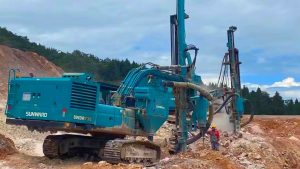Directional Drilling: Achieving Unprecedented Precision
Directional drilling has revolutionized the oil and gas industry, allowing for greater precision and efficiency in extracting resources. This advanced technique enables operators to reach previously inaccessible reserves, optimize well placement, and minimize environmental impact. In this comprehensive guide, we’ll explore the intricacies of directional drilling, its benefits, applications, and the latest technological advancements driving its success. Directional Drilling: Achieving Unprecedented Precision
What is Directional Drilling?
Directional drilling is the practice of controlling the trajectory and deviation of a wellbore to reach a specific underground target. Unlike traditional vertical drilling, directional drilling allows for the creation of wells at various angles and directions, providing access to oil and gas reserves that are not directly below the drilling site.

The Evolution of Directional Drilling
The concept of directional drilling dates back to the early 20th century, but significant advancements were made in the 1970s with the introduction of downhole motors and measurement-while-drilling (MWD) technology. These innovations enabled greater control and accuracy, paving the way for the modern directional drilling techniques used today.
Benefits of Directional Drilling
Enhanced Resource Recovery
Directional drilling allows operators to access reserves located in complex geological formations. By drilling at various angles, it’s possible to reach multiple targets from a single wellbore, maximizing resource recovery and reducing the need for additional drilling sites. https://drillitco.com.au/drill-it-group-australia/
Environmental Benefits
One of the key advantages of directional drilling is its ability to minimize environmental impact. By drilling multiple wells from a single pad, the surface footprint is significantly reduced. This is particularly beneficial in environmentally sensitive areas, such as wetlands or densely populated regions.
Cost Efficiency
Directional drilling can be more cost-effective than traditional methods. By reaching multiple targets from one wellbore, operators save on drilling time, equipment, and labor costs. Additionally, the ability to avoid obstacles and navigate complex formations can lead to higher production rates and reduced operational risks.
Applications of Directional Drilling
Horizontal Drilling
Horizontal drilling is a subset of directional drilling where the wellbore is turned horizontally within the reservoir. This technique is particularly effective in shale formations, where horizontal wells can expose more of the reservoir to the wellbore, significantly increasing production rates.
Extended Reach Drilling (ERD)
ERD involves drilling wells that extend several kilometers horizontally from the drilling site. This technique allows operators to reach reserves located far from the drilling rig, making it possible to tap into offshore or remote onshore deposits without the need for multiple rigs.
Multilateral Drilling
Multilateral drilling involves creating multiple lateral branches from a single main wellbore. This approach maximizes reservoir contact and can significantly enhance production rates. Multilateral wells are particularly useful in complex reservoirs where multiple zones of interest are present.
Technological Advancements in Directional Drilling
Rotary Steerable Systems (RSS)
Rotary steerable systems have revolutionized directional drilling by providing continuous steering control while drilling. These systems use sophisticated sensors and downhole motors to adjust the wellbore trajectory in real-time, allowing for precise navigation through complex geological formations.
Measurement-While-Drilling (MWD) and Logging-While-Drilling (LWD)
MWD and LWD technologies provide real-time data on wellbore conditions, enabling operators to make informed decisions during the drilling process. MWD tools measure parameters such as inclination, azimuth, and toolface orientation, while LWD tools collect geological data, including formation density, porosity, and resistivity.
Automated Drilling Systems
Automation is playing an increasingly important role in directional drilling. Automated drilling systems utilize advanced algorithms and machine learning to optimize drilling parameters and improve efficiency. These systems can adjust drilling speed, weight on bit, and mud flow rates in real-time, reducing human error and enhancing overall performance.
Challenges and Future Trends in Directional Drilling
Technological Complexity
While directional drilling offers numerous benefits, it also presents significant challenges. The technological complexity of modern directional drilling equipment requires highly skilled personnel and rigorous maintenance protocols. Ensuring the reliability and accuracy of downhole tools is critical for successful operations.
Environmental and Regulatory Considerations
As with all drilling activities, directional drilling must comply with environmental regulations and standards. Operators must carefully manage drilling fluids, cuttings, and emissions to minimize environmental impact. Additionally, ongoing monitoring and reporting are essential to ensure compliance with regulatory requirements.
Future Trends
The future of directional drilling looks promising, with ongoing advancements in technology and techniques. Innovations such as real-time 3D visualization, enhanced downhole sensors, and improved data analytics are expected to further enhance precision and efficiency. Additionally, the integration of artificial intelligence and machine learning will likely play a significant role in optimizing drilling operations and reducing costs.
Conclusion
Directional drilling has transformed the oil and gas industry, offering unprecedented precision and efficiency in resource extraction. By enabling operators to reach previously inaccessible reserves, optimize well placement, and minimize environmental impact, directional drilling continues to drive innovation and growth in the sector. As technology continues to evolve, the future of directional drilling holds immense potential for further advancements and improved operational outcomes.

